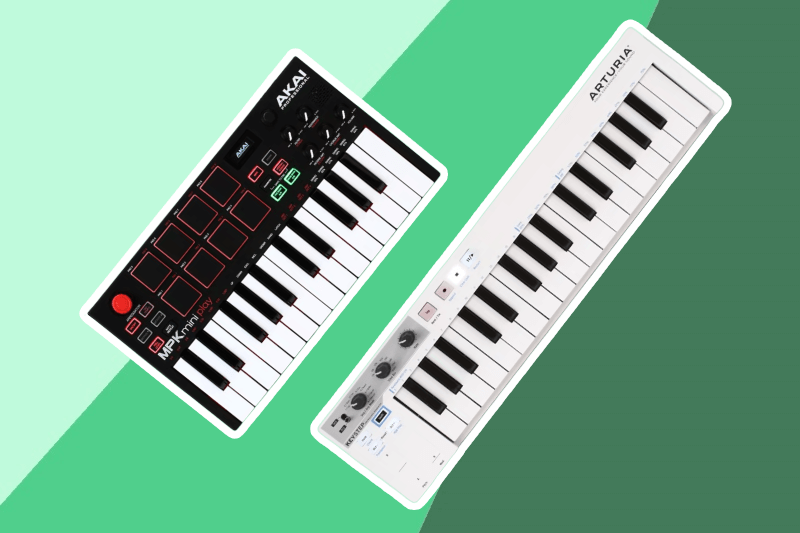
Do you want the best shot at making the most of your blooming talent as a new musician? For electronic music, mixing tracks or composing, the best MIDI keyboards for beginners should be on your shopping list, and we want to help you pick yours. Why is this article and its reviews so important? Because your music will only sound as good as your equipment allows and not all MIDI keyboards are the same.
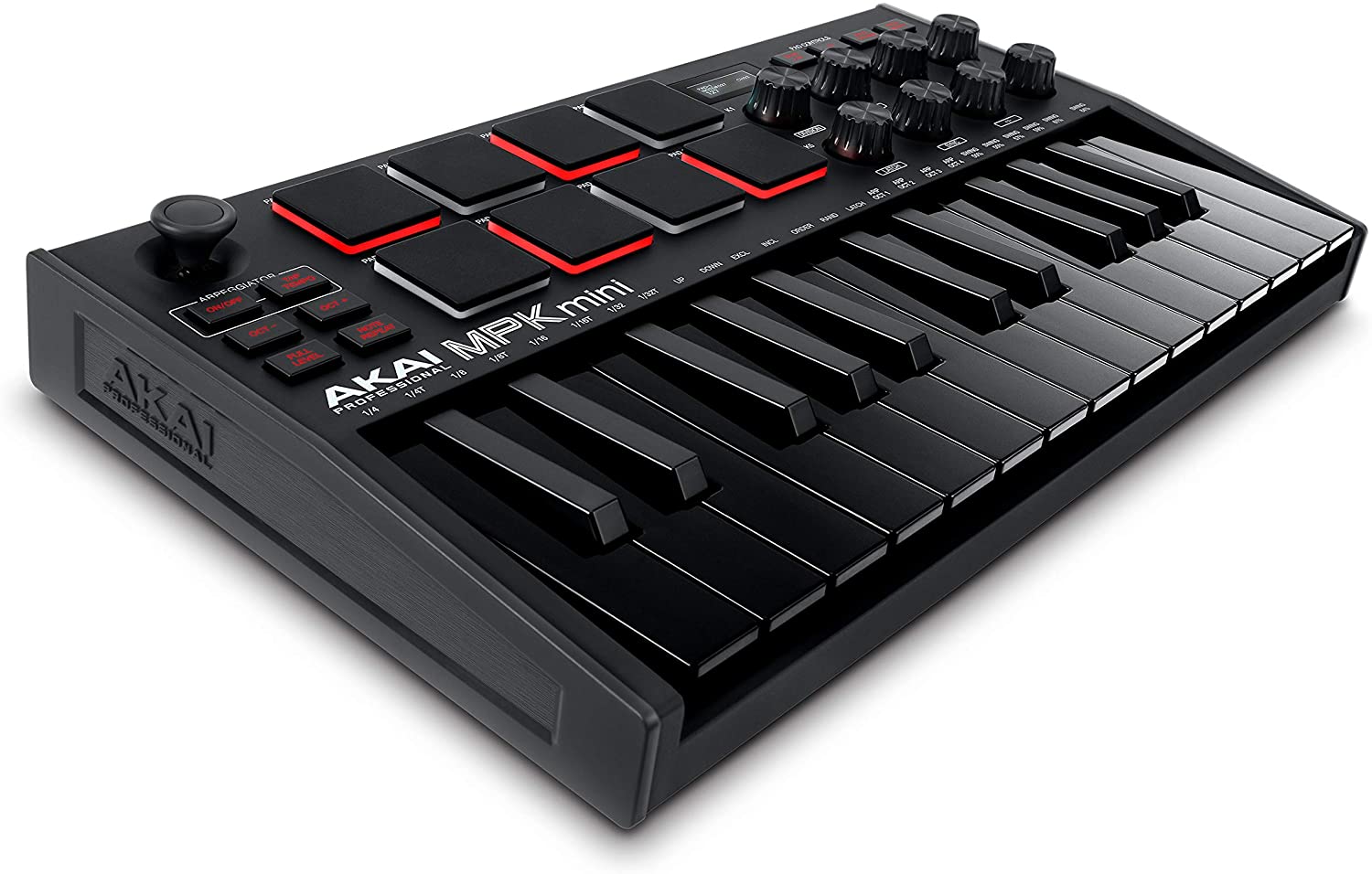

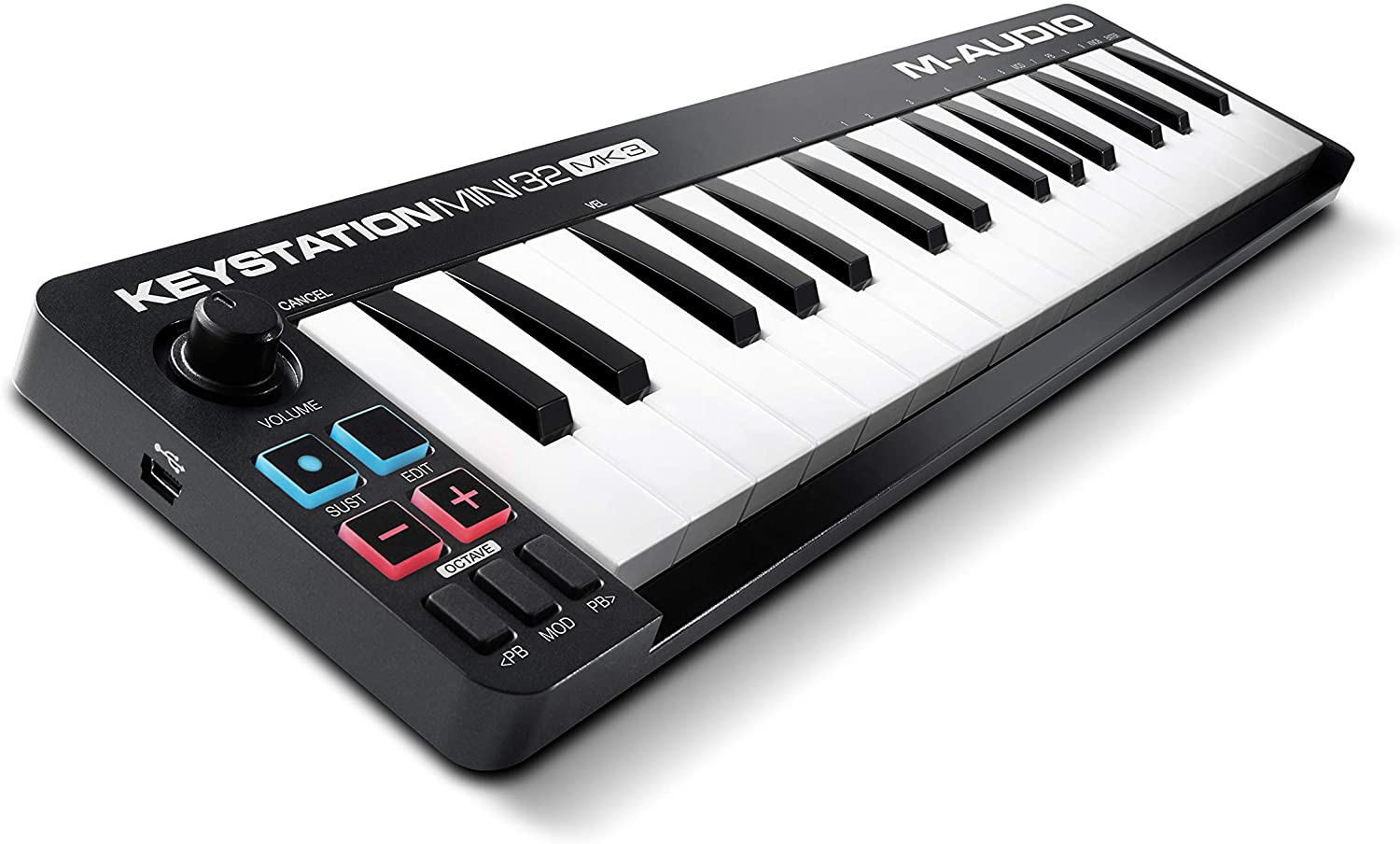



To find your key to enjoyment as well as musical success, browse our in-depth reviews, compiled through thorough research. We cover the different models’ ease of use, since this is essential for anyone who want to make their introduction to making quality music a smooth one. We also talk about connectivity and the number of keys to give you insight into each one’s capabilities. The buying guide will help you make an informed choice based on your unique needs and setup, while the comparison chart gives you an overview at a glance. Here’s all you need to know about this niche in modern music.
Other features: 6 virtual instruments; built-in arpeggiator; sustain pedal input jack

The MK3 model is our best MIDI keyboard for beginners because it’s an excellent example of getting almost all you need in one package. It’s a 25-key controller, which makes it compact, and since you can power if via USB, it’s portable and practical for use on the go. For a beginner who may take it somewhere to learn from others this makes for a practical investment.
Apart from the keys you have beat pads that give you versatile options to explore in your new hobby. You can discover which features you like best so you know what to invest in if you ever decide to buy larger equipment. This is further enhanced by the knobs that make mixing easier, so you can try out composition, mixing and more with just one purchase. Don’t forget the sustain pedal input, arpeggiator and velocity sensitive keys that create an overall professional feel.
The equipment also looks stylish, so if you use it for performances in future, you’ll already look like a pro.
Getting started is easy thanks to plug and play.
Other features: selectable velocity curves; Pro Tools included

M-Audio is a trusted brand in the music industry, and this model offers great value for money since you’re getting a slightly bigger unit with more keys than our first option above. For those who enjoy piano playing specifically, this is usually a plus. You can even enhance the range further thanks to octave up and down buttons.
You also get resources included, the much-respected ProTools software being one of them in this case, so even beginners can start making music like professionals.
It’s easy to start thanks to plug and play, and because it will work with either Mac or PC, it’s an option for anyone.
Once again, this unit is USB powered, making it a portable option.
Other features: AmazonBasics 4 Port USB 3.0 Hub power adapter can be included to purchase; sustain pedal input

If you want a USB powered unit instead of lugging around additional components, know that this is a starter MIDI keyboard favorite. A bonus is that it’s compatible with both USB 3.0 and USB 2.0. It’s very versatile because you can easily switch between bus power and the self-power mode. You may need to use a power adapter for best performance.
You don’t have the widest range of features, but as a beginner you’ll appreciate the neat and simple layout. Features include wheels for modulation and pitch, so you have the basics to start playing around with sounds. There are also transpose buttons, and you can extend an octave up or down, so you’re not too limited in options. The volume slider is within easy reach, and you do have the option of using a sustain pedal.
This unit is slightly lighter than some of our other models, which adds to its portability.
Other features: ProTools | First included; sustain pedal input jack
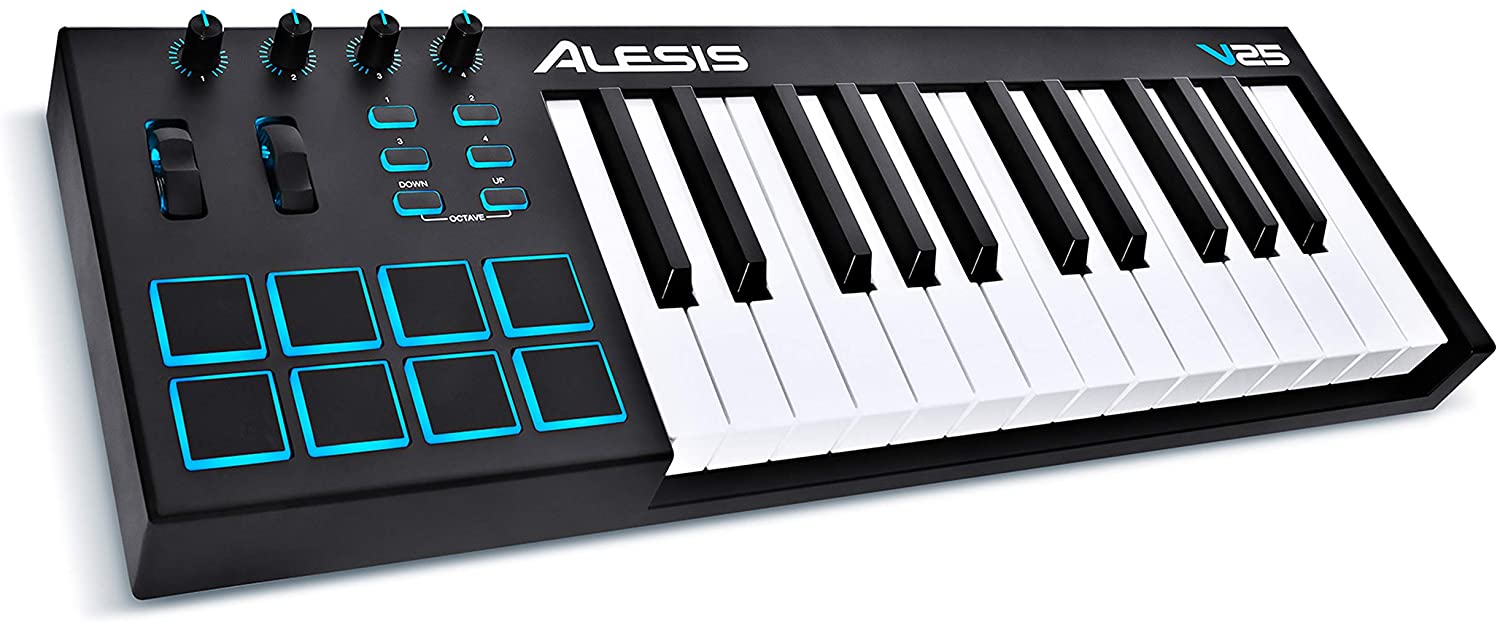
It’s amazing what Alesis managed to build into this small unit, with multiple knobs and pads in its layout along with the 25 keys. It’s your choice how you want to assign the knobs and buttons, giving you the chance for a custom setup that suits your style. Whether you want to change volume, parameters or filters when working with virtual instruments or even plugins providing you with interesting effects, this simple MIDI keyboard can do it for you.
You’ll enjoy the smooth movements of the knobs on this controller. We just think the buttons and pads could improve in design, so you don’t have to press them twice sometimes.
It’s up to you to set the velocity curves of the keys, once again allowing you to adjust your equipment to your requirements. This will become valuable when you develop and learn your personal preferences.
This is another USB powered unit, so you can easily take your equipment to beginners’ classes or wherever you want to make music.
Other features: 128 instruments and 10 drum sounds; OLED display; built-in speaker; can be powered with 3 AA batteries
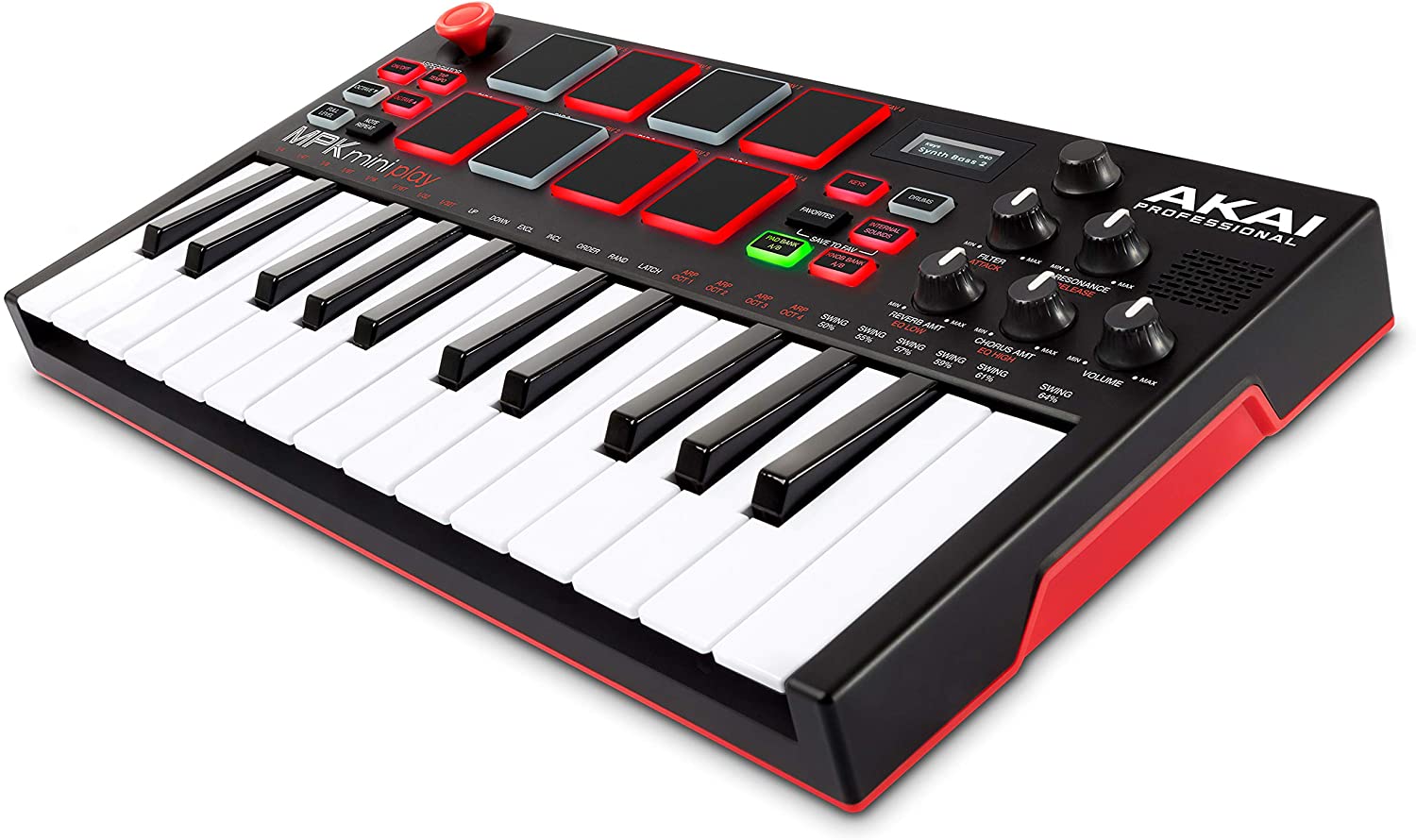
It’s impressive with AKAI managed to add to this beginner MIDI controller while still managing to make it portable. By placing all the buttons and knobs above the keys, you have a relatively short unit which makes it more practical for packing, if you plan to travel with your gear. This also makes it a welcome option if you have limited space in your studio.
In terms of functionality and quality, you’re working on equipment that comes from a leading brand, so you know you can trust it.
Your range of sound options is impressive, since it gives you 10 drum kits to pick from along with over 100 sounds. Access to the Pro Software suite and MPC Beats software further empowers beginners to create pro tracks. It can be tricky to install all this software, so ask an expert if you’re unsure.
When it comes to the keys, your personal preference may play a role. Some find the spring resistance in the velocity sensitive keys too high.
Other features: creative arpeggiator; fixed cord mode; bus-powered
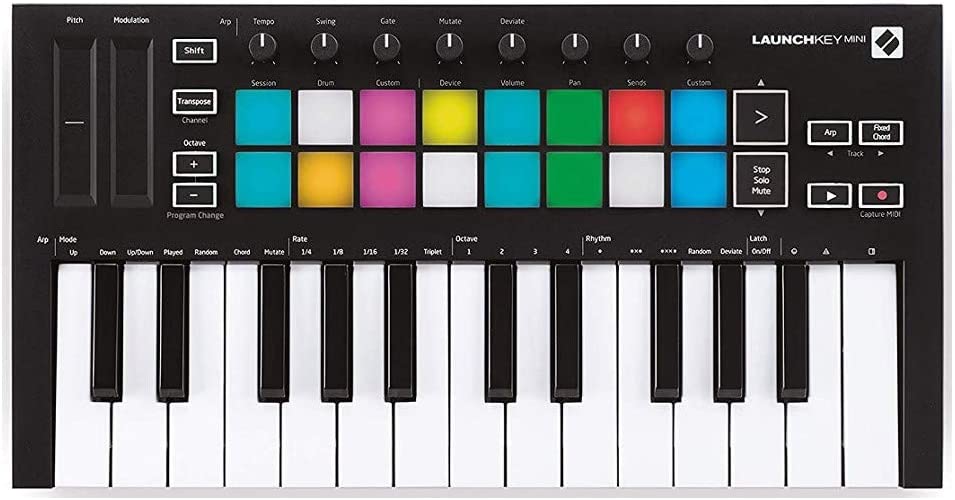
Even though this isn’t one of the smallest units in terms of size and length, an attractive feature is how light this MIDI keyboard synthesizer for beginners is. At only 1 pound, you won’t be weighed down when carrying your gear to a class or to a performance.
The buttons are attractive thanks to their different colored backlit feature. This turns your beginner controller into a showstopping piece of equipment if you perform with it on stage or want to impress friends at home.
You get a two-year warranty on this device, which shows the quality you’re investing in.
Unlike the unit above, it can’t produce audio on its own, so you do need additional equipment to hear what you’re producing.
You will enjoy using this model more than certain others, since it’s an upgrade on the brand’s previous models and they improved the pads’ and keys’ sensitivity.
Other features: works with all MIDI music applications; 5 user presets; foot switch connector
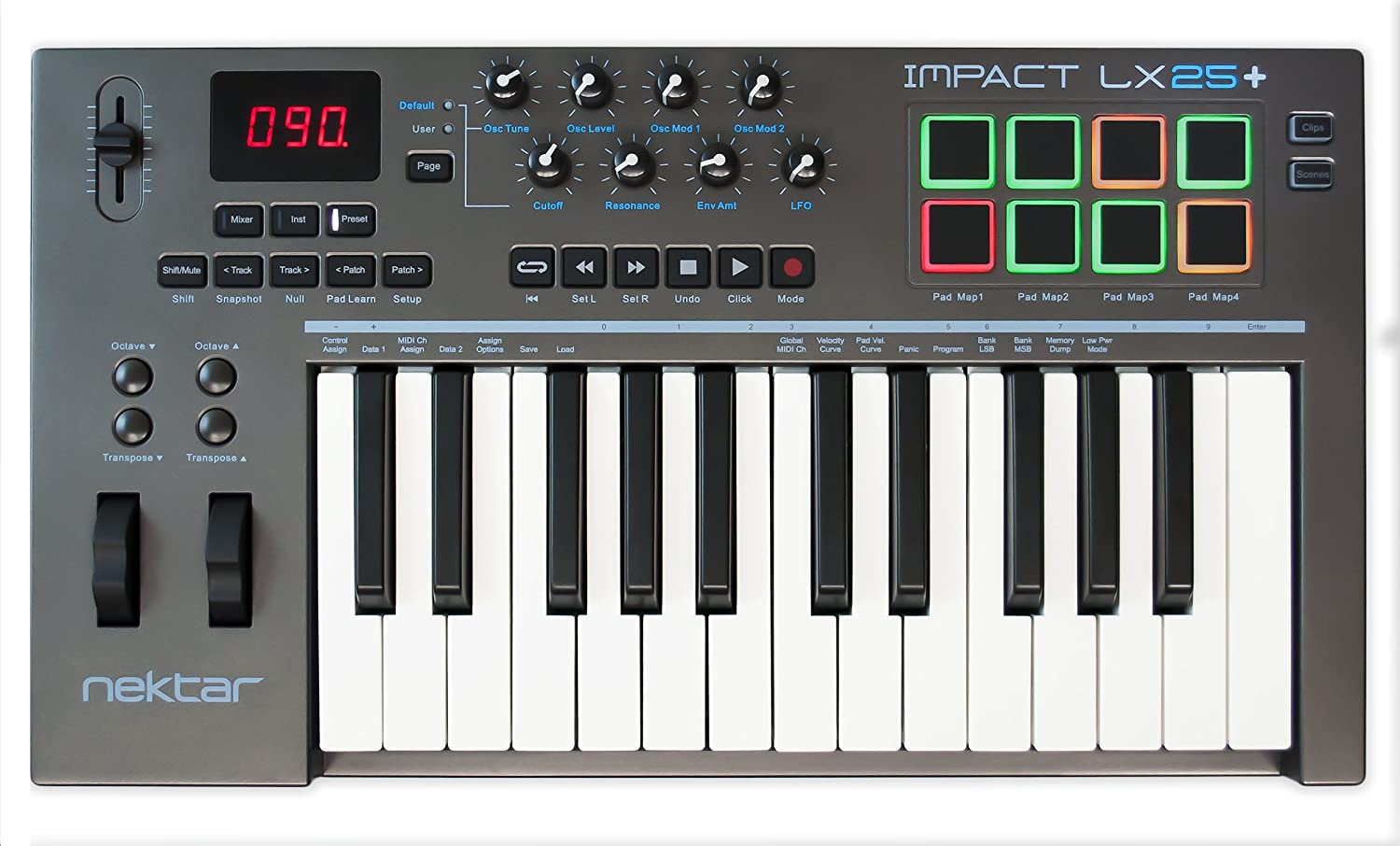
The reason this model from Nektar stood out as our best starter MIDI keyboard for production is because you can use it for so many different music genres. This is because there are different velocity curves along with modulation wheels and other features. This allows different types of players to share their compositions while everyone will feel comfortable using this keyboard. So, if you and some friends want to explore your talents, this one can cater for you all.
Its diversity also lies in the range of options you’ll find on the control panel, so you can do a lot straight from your MIDI controller, without even working on a computer. This includes, rewinding, forwarding, recording, patching up or down and so much more. You can also control DAW mixer channels by using its LX+ encoders.
With five user presets, once again this model can cater for different users’ preferences, or you can use multiple devices during your music production, and switching between them will be effortless.
Other features: 8 user presets; sustain pedal jack
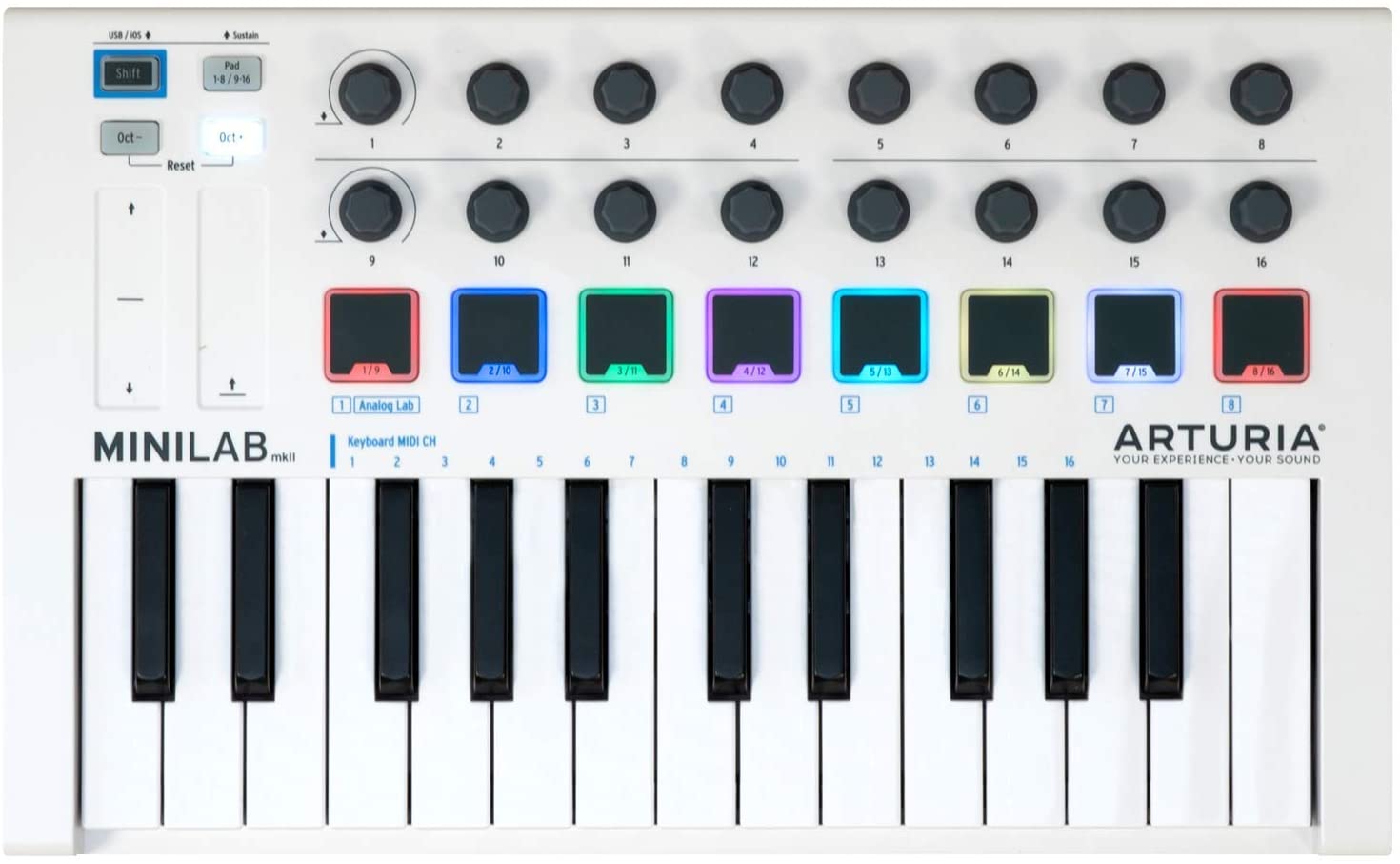
Here is another of our best models for beginners, that has a surprising number of controls on its interface. There’s a total of 16 encoders and it’s up to you how to assign them. Yes, this unit can also control your DAW, so you don’t necessarily have to sit in front of the computer when mixing tracks. This gives you more flexibility in how you want to set up your studio. The encoders are sensitive to pressure levels, giving you extreme control over your final product.
You’ll see that the multiple instruments as well as synthesizers are ready to use when you unbox it, so as a beginner you won’t waste time on setup.
The brand put in effort to improve on other models, so you now have a more impressive pitch bend and the control accuracy is also better. The brand even looked at small details such as not having LEDs flashing, since this tended to distract some users. Now they’re on continuously which looks great and won’t bother you while you’re busy composing.
Handy extras include an input for a sustain pedal.
Other features: LCD screen; sustain pedal input jack; DirectLink; Touch Loops’ 2GB sample library
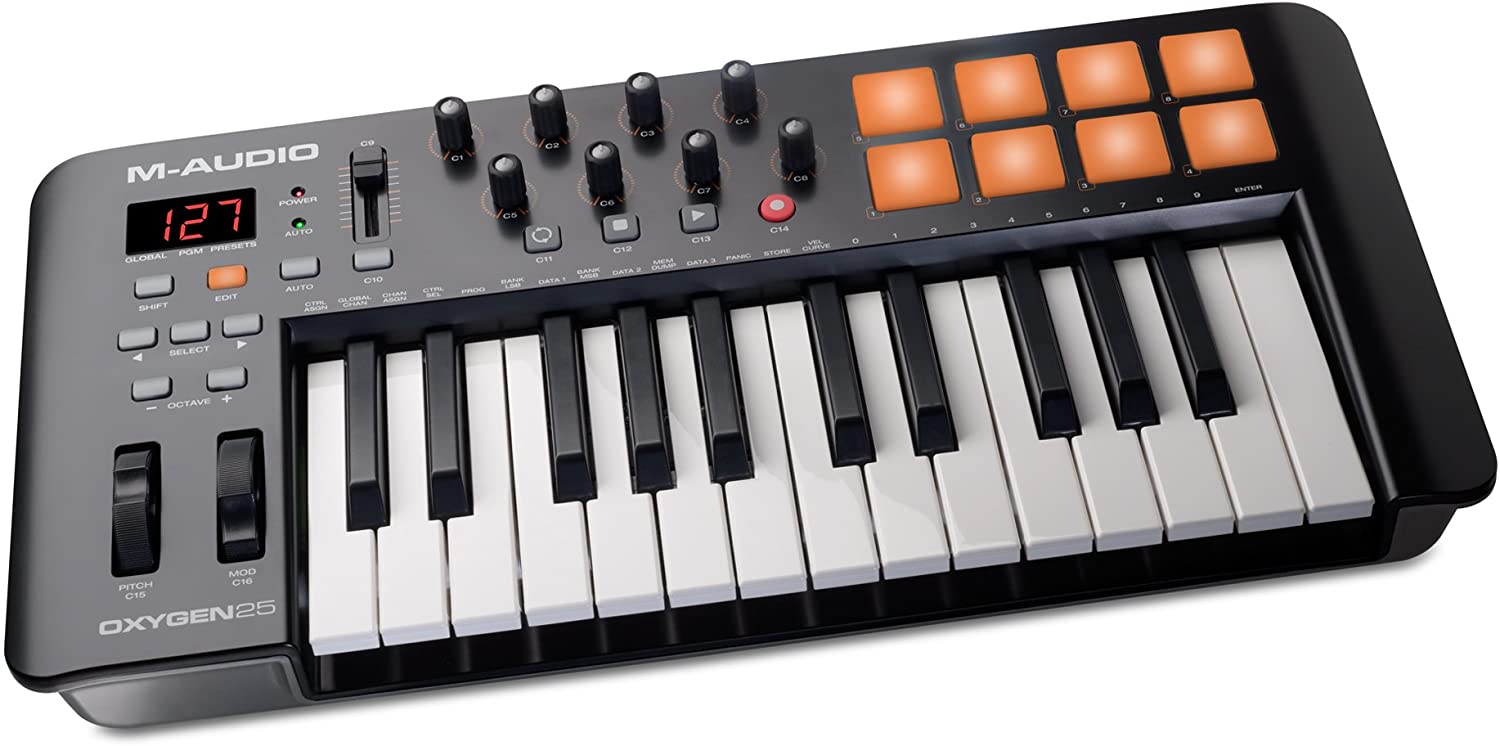
If you know you’ll mostly use your MIDI controller for beginners at home or in a studio instead of looking for a portable unit, try this one. Firstly, it has a range of controls you can access straight from its surface, so working on your DAW isn’t even necessary—you do much of the mixing from your controller.
Secondly, this is a bigger unit, measuring much longer than some of the portable units on our list. That makes it more appropriate as equipment that remains stationary in one place most of the time. It’s also much heavier than units we’ve reviewed here, so you don’t necessarily want to carry this one around.
Other features: Sequencer, Arpeggiator, and Controller modes; compatible with most existing synthesizers; CV outputs; sustain pedal output jack
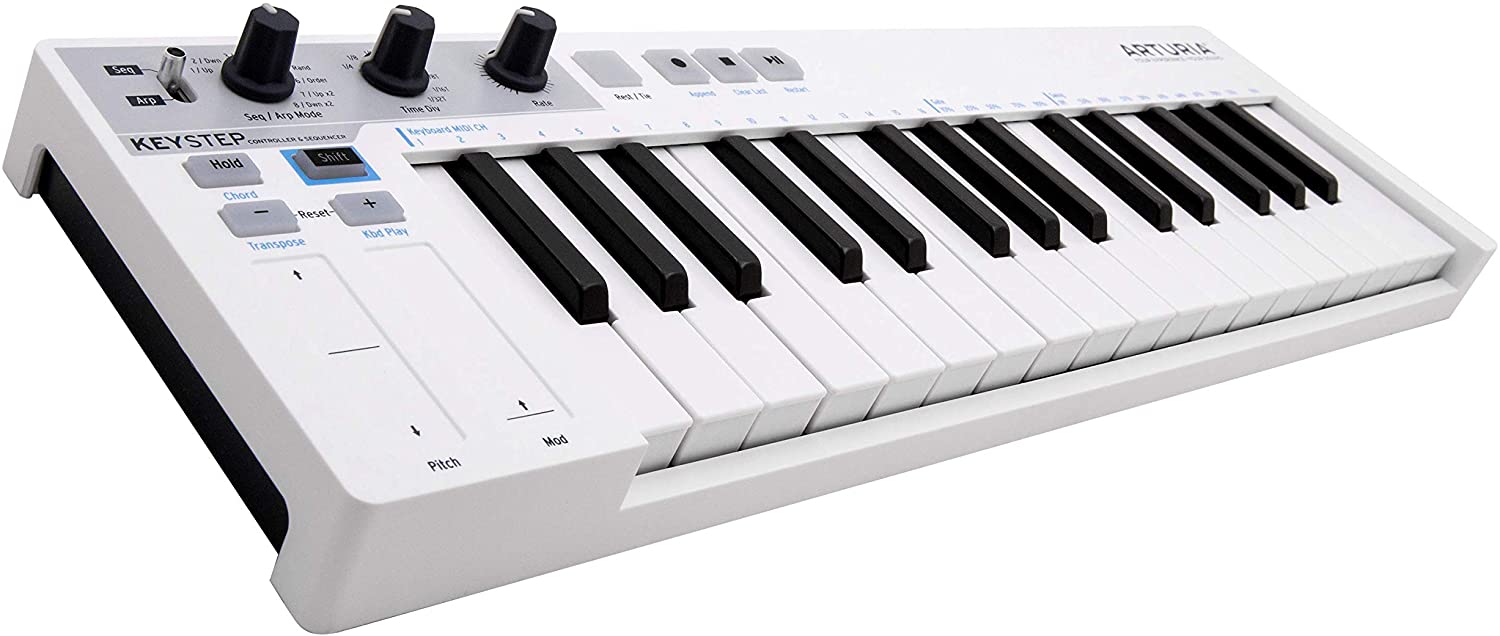
This starter MIDI keyboard is last on our list, but still a wise investment since the brand built in multiple features into one unit. It’s a smart fusion of a MIDI controller and a keyboard that still makes you feel as if you’re playing on a quality piano or keyboard. Since the experience can add to your creativity at any given moment, this is important for beginner composers and producers. There are also features of a polyphonic step sequencer built into this unit. All of this is why it’s our upgrade pick. Perhaps after you’ve tried a standard MIDI controller you’ll want to invest in this, and since it comes at a very reasonable price, it’s still budget friendly to add this to your gear.
You’ll notice this one has more keys than most of the models on our review list that only have 25. While this makes it bigger, it also gives you a wider range for playing, a feature that could be valuable for those used to playing on standard pianos who now want to try out other aspects of music production.
With the unit having more keys and various features, including buttons for stop, play and record as well as other controls, it’s obvious that it’s larger and heavier than many portable models.
When you pursue a passion like music, your equipment should enhance your experience, not hamper it. We compiled this buying guide about beginner MIDI controller shopping, to help you make the right choice from the start.
If you’re just getting into this business, this guide is what you’ll need. We cover everything from what these pieces of equipment are exactly, to identifying the best ones for your use. How much does connectivity matter and which features will ensure you get value for money? It’s important to truly understand these aspects, because each musician is different. You need to identify what will work for you in terms of key action, software, weight and many other features mentioned below.
So, keep reading to shop like a pro muso.
Firstly, MIDI (Musical Instrument Digital Interface) refers to a certain protocol. This was designed to help hardware like computers and musical instruments to communicate with each other.
With your MIDI controller sending data to your DAW (Digital Audio Workstation) on your computer, you can simplify creating sounds during composing music or producing tracks. Easily add sounds by playing the notes on the keyboard or pressing the drum pads, instead of using your PC keyboard or manually writing in each note as MIDI information. With this tool you can edit, enhance and even replace sounds to suit you. Your MIDI will do it all.
Note that it’s not your controller producing the sounds; it simply sends data or information to your other equipment to create the sounds.
In our beginner MIDI controller reviews you saw that there are different models and types. Each one was designed to cater for a specific need and you need to determine which features will be most valuable to you. Here are the most important specs to consider and understand in order to make an informed decision.
The keys are the primary feature of a MIDI controller, but the more controls you have, such as the pads you find on the AKAI Professional MPK Mini MK3, the better.
The most popular controls include:
Most of our starter MIDI keyboard models above have 25 keys, but as you can see in the Arturia Keystep Controller & Sequencer, some have even more. There are different designs, usually being 25, 49, 61 or 88. But then you saw that it can also be 32 and even 37 is a common occurrence.
Having 25 keys is enough on a beginner MIDI controller and this also suffices if you’re looking for a portable unit or when your studio has limited space. However, when you progress you may want more keys to make it easier to create more elaborate tracks and use both hands at once. This is why many pros prefer 49 keys at least, especially if they don’t often travel with their gear.
Remember the number of keys doesn’t always limit you in how high or low your notes can be. For example, you have Octave up and down buttons on many models we reviewed.
Research the key action because it will impact how comfortably you play. There’s not necessarily a best type of action; it simply needs to suit your needs. The main types are:
A MIDI controller on its own doesn’t offer you much, since it’s meant to use with other equipment. For example, it needs to be connected to your computer. Look at how it connects to your PC so you know you’ll have a simple setup. A plug-and-play unit usually doesn’t require much effort in terms of installing software or downloading sounds. You can simply switch on and start mixing.
Also see what you need to connect to, to power your controller. A USB powered unit is very handy since you won’t need an open wall socket to plug in yet another power supply. Simply link it to your computer and you’re ready. This also makes it portable and practical for taking your gear with you wherever you go.
Other connections include Bluetooth which can be handy but may be less stable than connecting via cable. And if you have inputs for headphones, sustain pedals and other devices they always come in handy.
You can see that many of the models we reviewed have DAW and other software packages included. This supplies you with sounds and many mixing features right from the start, instead of having an additional expense to set up your studio. Look for software that’s known for its user friendliness and that will work on your PC. For example, GarageBand is popular music creation software, but it’s meant for Mac, not a Windows computer.
Other popular DAW options include Ableton and Pro Tools. If you have software that the industry uses, there will be no reason to upgrade later on, saving you money in the long run.
The size and weight of your MIDI controller will determine its portability, which is very important if you’ll travel with your gear. This could be because you’re an aspiring performer using your MIDI on stage, or you may attend classes to improve your skills. This is where compact units like the Akai Professional MPK Mini Play come in handy. Designs like this one won’t weigh you down or take up much space. The latter is also important if you have limited space available in your studio.
If you want a more comfortable play experience you may sacrifice small dimensions for having more keys, as can be found in the M Audio Keystation Mini 32 MK3 and Arturia Keystep Controller & Sequencer. So, first consider what you’ll use your controller for before deciding on the ideal size.
A warranty shows a brand’s faith in the quality of their product, so it’s worthwhile comparing different models. You can get a warranty of up to 2 years on a model like Novation Launchkey Mini MK3, so don’t settle for too short a period of cover. Your controller may undergo a lot of heavy handling especially if you travel with it, and you don’t want to pay for a replacement too soon.
An interesting fact is that you can actually use a synthesizer as a MIDI controller. For this to work the synthesizer must be able to give an output of a MIDI signal, whether through an appropriate MIDI cable or a USB connection.
It’s time to pursue your dream and improve your skills as a musician, composer or producer. Find the best MIDI keyboard for beginners among our list of options and you’ll be ready.
We suggest you try the AKAI Professional MPK Mini MK3, since you can’t go wrong trusting an industry favorite brand. Also, this one is fairly compact while still giving you loads of features like its quality drum pads.
You may want more keys, in which case our Best Value option, the M-Audio Keystation Mini 32 MK3 is a winner. With plug and play it’s easy enough for any beginner to try out.
Make sure your setup is easy by picking a model like the Midiplus AKM320 with keyboard controller. With the USB hub you can power it up almost anywhere so your new hobby can be enjoyed wherever you go.
You have the insight thanks to our buying guide. Now, pick the best MIDI keyboard for beginners for your use.